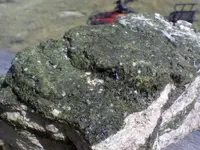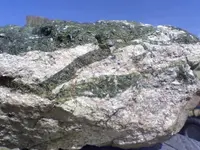jewelerdave
Hero Member
- Joined
- Aug 29, 2007
- Messages
- 848
- Reaction score
- 96
- Golden Thread
- 0
- Location
- Fort Collins, Colorado
- Detector(s) used
- I just follow my nose!...where the silver and gold goes!
Minelab 5000, Goldmaster, and a few others
XRF spectrometer, Common sense.
- Primary Interest:
- Prospecting
Over last summer while gem hunting in Wyoming following some leads I was found on some private property and asked to leave but then asked to Id some things when they found out I was a jeweler.
The ranch hand asked if I could Id something for him he found, I said sure. he told me of a rock covered in Green Crystals and didnt know what it was.
He went back to the ranch house and came back with this rock.
I was able to take a couple pictures of a weird specimen that the local ranch hand had found.
Problem, I am not sure what the heck it is.
The country rock is just a quartz/feldspar granite.
First I thought maybe an olivine or tourmaline. Probably a massive olivine but I want to see what others have to say.
This area has had in the last couple years discoveries of Ruby/Sapphire, Iolite and quite frankly nothing would surprise me from this area that I would not otherwise consider.
Just in the last 10 years new gem deposits in Wyoming have been ruby/Sapphire, peridot, iolite, diamond, Chrome Diopside and the list just keeps growing.
The ranch hand asked if I could Id something for him he found, I said sure. he told me of a rock covered in Green Crystals and didnt know what it was.
He went back to the ranch house and came back with this rock.
I was able to take a couple pictures of a weird specimen that the local ranch hand had found.
Problem, I am not sure what the heck it is.
The country rock is just a quartz/feldspar granite.
First I thought maybe an olivine or tourmaline. Probably a massive olivine but I want to see what others have to say.
This area has had in the last couple years discoveries of Ruby/Sapphire, Iolite and quite frankly nothing would surprise me from this area that I would not otherwise consider.
Just in the last 10 years new gem deposits in Wyoming have been ruby/Sapphire, peridot, iolite, diamond, Chrome Diopside and the list just keeps growing.






